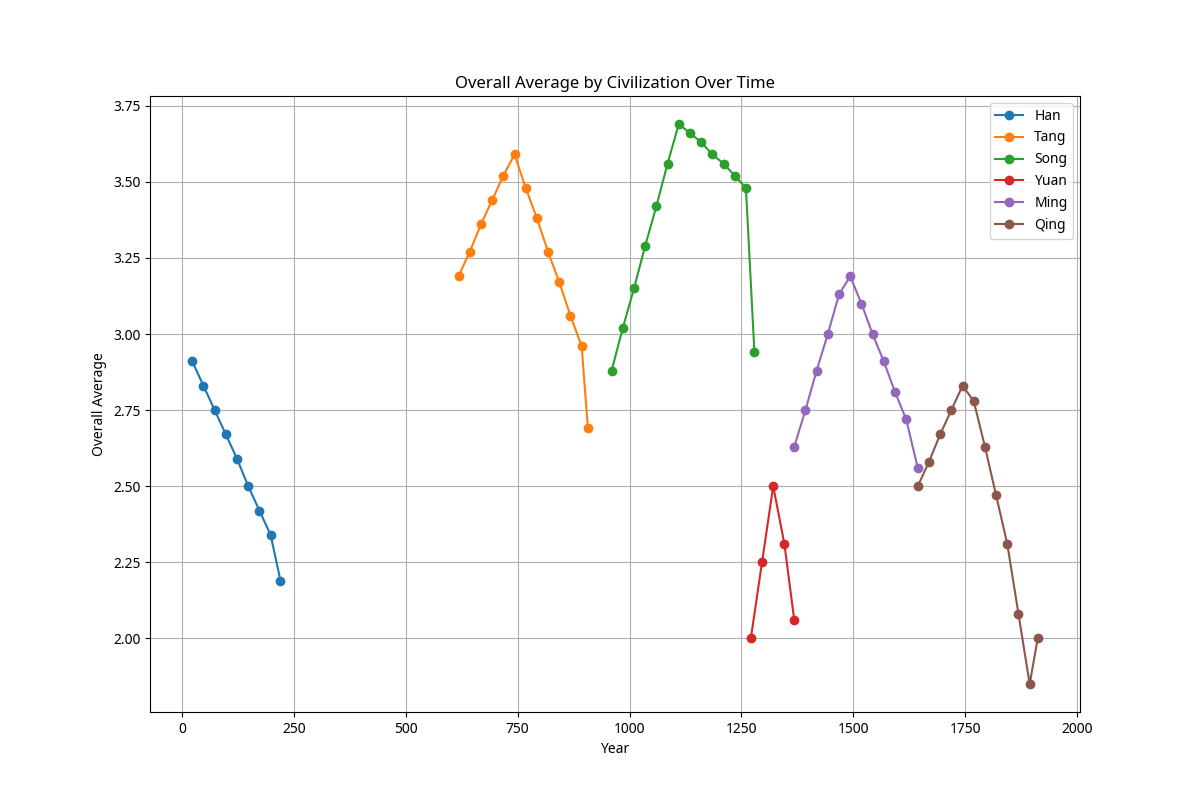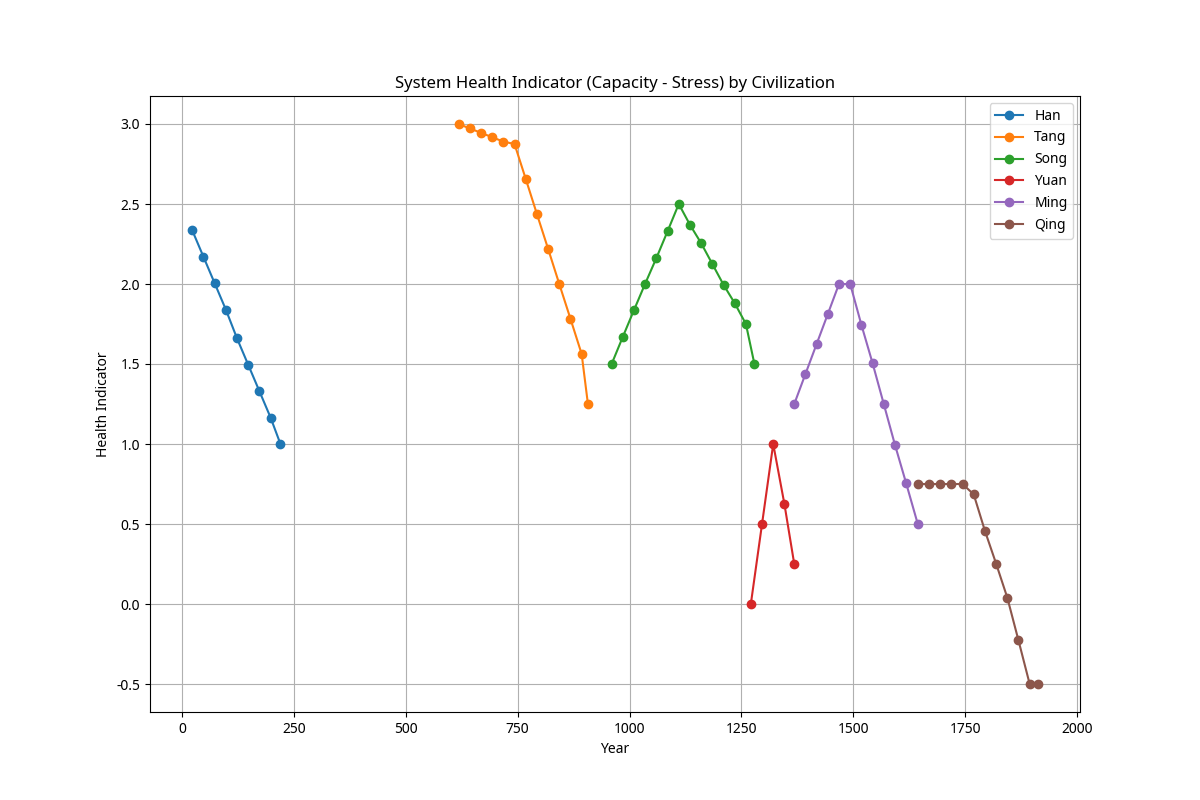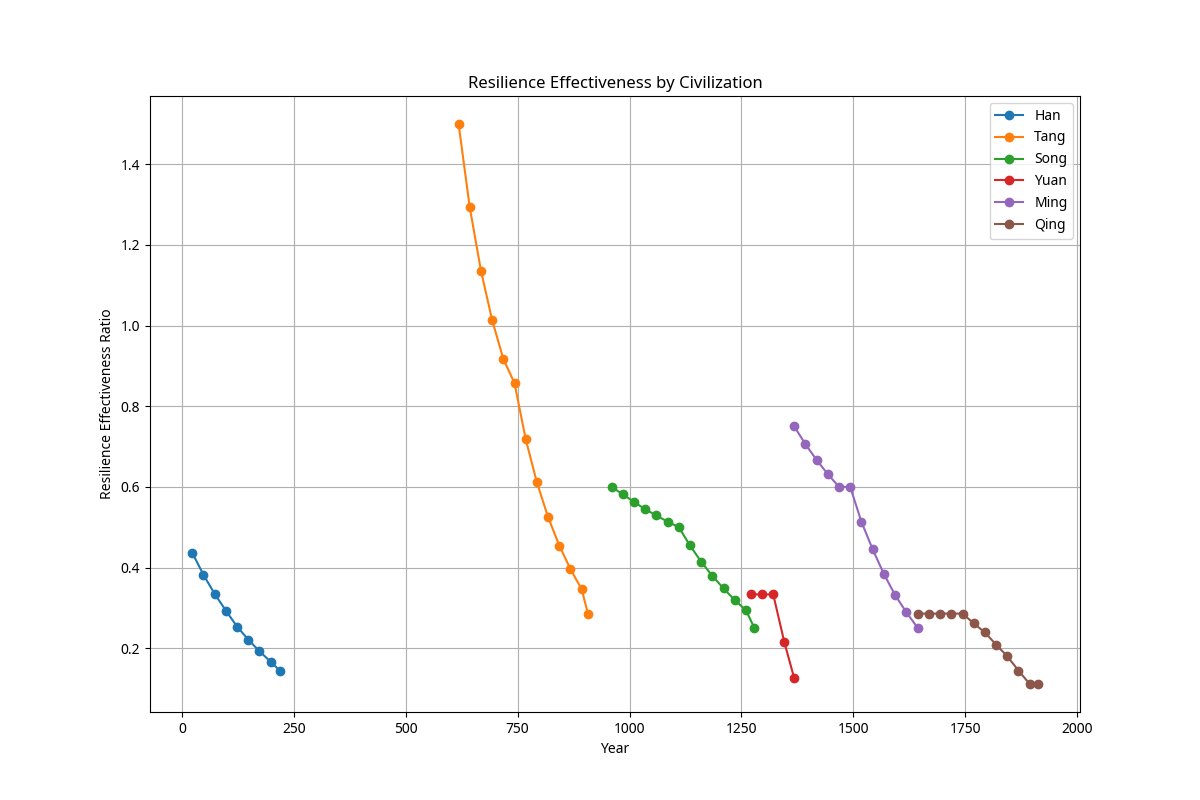Introduction
This analysis examines historical Chinese dynasties through the lens of Complex Adaptive Systems (CAS) theory, applying both quantitative metrics and theoretical frameworks to understand the dynamics of civilizational rise, stability, and decline. By treating civilizations as complex adaptive systems, we can identify emergent patterns, feedback loops, and adaptation mechanisms that explain their development trajectories and ultimate fates.
The data tracks six Chinese dynasties (Han, Tang, Song, Yuan, Ming, and Qing) across multiple metrics organized into four fundamental categories: Coherence, Capacity, Activity/Adaptability, and Stress. These metrics align with the mathematical foundations presented in the "13 Laws of History," which provides a theoretical framework for analyzing civilizations as complex systems.
Complex Adaptive Systems Framework
Complex Adaptive Systems are characterized by multiple interacting elements, non-linear relationships, feedback loops, emergent behavior, and adaptation mechanisms. These systems cannot be understood through reductionist approaches, as their behavior emerges from the interactions of components rather than from the properties of individual elements.
Interacting Elements
Systems contain many components/agents that interact dynamically, with interactions that can be physical or involve information exchange.
Non-linearity
Small changes in inputs can cause large effects or significant changes in outputs, making system behavior unpredictable through simple linear extrapolation.
Feedback Loops
Interactions can feed back onto themselves (recurrency), creating both positive (amplifying) and negative (dampening) feedback that shapes system behavior.
Emergent Behavior
Overall system behavior cannot be predicted by individual element behavior; new properties emerge at the system level that aren't present in components.
Self-organization
Systems organize without external direction, with order emerging from interactions among components rather than central control.
Adaptation
Systems and agents adapt to changing environments, updating strategies in response to inputs from other agents and evolving over time.
Mapping Civilization Metrics to CAS Properties
The civilization data tracks metrics that correspond directly to key CAS properties:
Coherence (χ) Metrics
- Cultural Cohesion
- Institutional Alignment
- Social Trust
- Identity Stability
These metrics represent the system's internal connectivity and self-organization. Higher coherence indicates stronger self-organization and more robust emergent patterns.
Capacity (κ) Metrics
- Economic
- Institutional Complexity
- Technology/Intelligence
- Abstract Organization
These metrics represent the system's resources, capabilities, and complexity. Higher capacity enables more sophisticated emergent behaviors and greater adaptive potential.
Activity/Adaptability (α) Metrics
- Adaptability
- External Influence
- Strategic Focus
- Social Mobility
These metrics represent the system's ability to change, learn, and respond to both internal and external stimuli. They capture the dynamic nature of complex adaptive systems.
Stress (σ) Metrics
- Internal
- Environmental
- External
- Resilience
These metrics represent perturbations and challenges to system stability. The balance between stress and capacity determines system viability, while stress distribution affects overall stability.
Emergent Behaviors and Patterns
Analysis of the civilization data reveals several emergent patterns characteristic of complex adaptive systems:
Cyclical Patterns of Rise and Decline

All six Chinese dynasties show clear cyclical patterns of rise, peak, and decline when measured by overall average metrics. This pattern is a classic emergent behavior in complex adaptive systems, where system-level properties emerge from the interactions of components rather than from central direction.
Key observations:
- Each dynasty follows an inverted U-shaped trajectory
- The rise phase is typically steeper than the decline phase
- The Tang and Song dynasties achieved the highest overall averages
- The Yuan dynasty had the shortest duration and lowest peak performance
System Health Dynamics

The health indicator (calculated as Capacity_Avg - Stress_Avg) shows particularly interesting patterns:
- Initial Health Advantage: Most dynasties begin with a relatively high health indicator
- Health Deterioration: All dynasties show eventual deterioration in health indicators
- Tang Dynasty Anomaly: The Tang dynasty began with an exceptionally high health indicator (3.0)
- Terminal Decline: The final years of most dynasties show accelerated health deterioration
- Qing Dynasty Vulnerability: The Qing dynasty is the only one to reach significantly negative health indicators
Phase Transitions and Critical Points
The rate of change analysis reveals potential phase transitions (significant shifts in system state) across all dynasties:
- Tang Dynasty Transitions: Multiple significant transitions occurred around 768, 793, 818, 843, 868, 893, and 907 CE
- Song Dynasty Collapse: A dramatic phase transition occurred in 1279 CE
- Yuan Dynasty Volatility: Despite its short duration, the Yuan dynasty experienced multiple transitions
- Late Qing Acceleration: The Qing dynasty shows accelerating negative transitions in its later period
These phase transitions align with the concept of critical thresholds in complex adaptive systems, where small changes in parameters can lead to dramatic shifts in system behavior once certain thresholds are crossed.
Feedback Loops and Adaptations
The analysis reveals sophisticated feedback loops and adaptation mechanisms that influenced dynasty longevity, stability, and eventual decline:
Key Feedback Mechanisms
Coherence-Stress Feedback Loop
As stress increases, coherence typically decreases, creating a negative feedback loop that can accelerate system decline. The Tang dynasty initially maintained high coherence despite increasing stress, suggesting effective buffering mechanisms.
Capacity-Coherence Feedback Loop
Higher coherence enables greater capacity development, which in turn can support coherence maintenance. The Song dynasty maintained capacity growth even as coherence began to decline, suggesting technological innovation compensating for social fragmentation.
Adaptability-Stress Feedback Loop
Low to moderate stress levels often trigger increased adaptability (positive feedback), but beyond certain stress thresholds, adaptability decreases (negative feedback). The Tang dynasty maintained high adaptability despite increasing stress for an extended period.
Adaptation Strategies Across Dynasties

The scatter plot of external versus internal adaptation strategies shows clear patterns:
- Tang Dynasty Strategy: High external adaptation with moderate internal adaptation
- Song Dynasty Strategy: Balanced but high adaptation on both dimensions
- Ming Dynasty Strategy: Moderate adaptation on both dimensions with slightly higher internal focus
- Yuan Dynasty Strategy: Low adaptation on both dimensions
- Qing Dynasty Pattern: Initially low adaptation on both dimensions, with gradual increase in internal adaptation during middle period
Resilience Effectiveness

The Resilience Effectiveness metric (calculated as Resilience divided by total stress) shows distinctive patterns:
- Tang Dynasty Superiority: Exceptional initial resilience effectiveness that gradually declined
- Song and Ming Moderation: Moderate resilience effectiveness maintained for extended periods
- Terminal Decline Pattern: All dynasties show sharp drops in resilience effectiveness in their final periods
Dynasty-Specific CAS Analysis
Han Dynasty (202 BCE - 220 CE)
The Han dynasty shows a steady decline in metrics from its early period, suggesting a gradual loss of system coherence and capacity over time. The data captures only the later period of the Han, showing the terminal decline phase of this complex adaptive system.
Key CAS Characteristics: Declining coherence, decreasing adaptation capacity, increasing stress
Tang Dynasty (618-907 CE)
The Tang dynasty exemplifies a highly successful complex adaptive system with exceptional balance of high coherence, capacity, and adaptability with low stress. It maintained positive feedback between coherence and capacity for an extended period and demonstrated strong emergence, self-organization, and adaptation.
Key CAS Characteristics: Strong emergence, self-organization, and adaptation with exceptional resilience effectiveness
Song Dynasty (960-1279 CE)
The Song dynasty represents a different CAS configuration with balanced internal and external adaptation and strong technological focus. It showed unusual capacity growth despite coherence decline in later period and maintained moderate resilience effectiveness through technological innovation.
Key CAS Characteristics: Strong information integration and innovation-integration balance
Yuan Dynasty (1271-1368 CE)
The Yuan dynasty demonstrates an unstable complex adaptive system with low starting metrics across all categories and limited adaptation on both internal and external dimensions. It showed minimal positive feedback between coherence and capacity and experienced multiple transitions indicating system instability.
Key CAS Characteristics: Limited self-organization and adaptation capacity
Ming Dynasty (1368-1644 CE)
The Ming dynasty shows a moderately successful complex adaptive system with moderate starting metrics and balanced development. It employed moderate adaptation on both dimensions with slightly higher internal focus and maintained stable feedback relationships without exceptional strengths.
Key CAS Characteristics: Good balance of system properties without exceptional strengths
Qing Dynasty (1644-1894 CE)
The Qing dynasty illustrates a complex adaptive system with declining adaptation, starting with moderate coherence but limited capacity and adaptability. The coherence-capacity feedback weakened over time, and resilience effectiveness declined to negative values in the later period.
Key CAS Characteristics: Increasing entropy and declining adaptation capacity
Implications and Insights
The analysis of Chinese dynasties as complex adaptive systems yields several important insights:
Coherence as Foundation
System coherence emerges as the most critical factor for civilization longevity, with a stronger correlation to duration (0.905) than any other metric. This suggests that maintaining internal alignment, cultural cohesion, and institutional coordination is more fundamental to system survival than raw capacity or stress avoidance.
Multiple Interacting Feedback Loops
Civilizations operate through multiple interconnected feedback mechanisms that can either reinforce or counteract each other. The balance and interaction of these feedback loops—particularly between coherence, capacity, and stress—largely determine system trajectories.
Adaptation Strategy Diversity
Different dynasties employed distinct adaptation strategies, with varying degrees of success depending on their context and challenges. No single adaptation strategy proved universally superior, suggesting that effective adaptation must be contextual and responsive to specific system conditions.
Threshold Effects and Non-linearity
Feedback loops often exhibit threshold effects, where gradual changes suddenly lead to dramatic system transformations once critical thresholds are crossed. This non-linearity is evident in the phase transitions identified across all dynasties, particularly in their terminal periods.